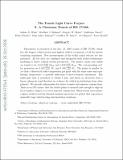| dc.contributor.author | Winn, Joshua Nathan | |
| dc.contributor.author | Holman, Matthew J. | |
| dc.contributor.author | Henry, Gregory W. | |
| dc.contributor.author | Torres, Guillermo | |
| dc.contributor.author | Fischer, Debra A. | |
| dc.contributor.author | Johnson, John Asher | |
| dc.contributor.author | Marcy, Geoffrey W. | |
| dc.contributor.author | Shporer, Avi | |
| dc.contributor.author | Mazeh, Tsevi | |
| dc.date.accessioned | 2010-03-03T18:06:33Z | |
| dc.date.available | 2010-03-03T18:06:33Z | |
| dc.date.issued | 2009-03 | |
| dc.date.submitted | 2008-08 | |
| dc.identifier.issn | 0004-637X | |
| dc.identifier.uri | http://hdl.handle.net/1721.1/52014 | |
| dc.description.abstract | Photometry is presented of the 2007 December 25 transit of HD 17156b, which has the longest orbital period and highest orbital eccentricity of all the known transiting exoplanets. New measurements of the stellar radial velocity are also presented. All the data are combined and integrated with stellar-evolutionary modeling to derive refined system parameters. The planet's mass and radius are found to be 3.212[superscript +0.069] [subscript –0.082]M [subscript Jup] and 1.023[superscript +0.070] [subscript –0.055]R [subscript Jup]. The corresponding stellar properties are 1.263[superscript +0.035][subscript –0.047] M sun and 1.446[superscript +0.099] [subscript –0.067] R sun. The planet is smaller by 1σ than a theoretical solar-composition gas giant with the same mass and equilibrium temperature, a possible indication of heavy-element enrichment. The midtransit time is measured to within 1 minute and shows no deviation from a linear ephemeris (and therefore no evidence for orbital perturbations from other planets). We provide ephemerides for future transits and superior conjunctions. There is an 18% chance that the orbital plane is oriented close enough to edge-on for secondary eclipses to occur at superior conjunction. Observations of secondary eclipses would reveal the thermal emission spectrum of a planet that experiences unusually large tidal heating and insolation variations. | en |
| dc.description.sponsorship | United States–Israel Binational Science Foundation (BSF) | en |
| dc.language.iso | en_US | |
| dc.publisher | American Astronomical Society | en |
| dc.relation.isversionof | http://dx.doi.org/10.1088/0004-637x/693/1/794 | en |
| dc.rights | Article is made available in accordance with the publisher's policy and may be subject to US copyright law. Please refer to the publisher's site for terms of use. | en |
| dc.source | Josh Winn | en |
| dc.subject | stars | en |
| dc.subject | planetary systems | en |
| dc.title | THE TRANSIT LIGHT CURVE PROJECT. X. A CHRISTMAS TRANSIT OF HD 17156b | en |
| dc.type | Article | en |
| dc.identifier.citation | The Transit Light Curve Project. X. A Christmas Transit of HD 17156b
Joshua N. Winn, Matthew J. Holman, Gregory W. Henry, Guillermo Torres, Debra Fischer, John Asher Johnson, Geoffrey W. Marcy, Avi Shporer, and Tsevi Mazeh 2009 ApJ 693 794-803 doi: 10.1088/0004-637X/693/1/794 | en |
| dc.contributor.department | Massachusetts Institute of Technology. Department of Physics | en_US |
| dc.contributor.department | MIT Kavli Institute for Astrophysics and Space Research | en_US |
| dc.contributor.approver | Winn, Joshua Nathan | |
| dc.contributor.mitauthor | Winn, Joshua Nathan | |
| dc.relation.journal | Astrophysical Journal | en |
| dc.eprint.version | Author's final manuscript | |
| dc.type.uri | http://purl.org/eprint/type/SubmittedJournalArticle | en |
| eprint.status | http://purl.org/eprint/status/PeerReviewed | en |
| eprint.grantNumber | 2006234 | en |
| dspace.orderedauthors | Winn, Joshua N.; Holman, Matthew J.; Henry, Gregory W.; Torres, Guillermo; Fischer, Debra; Johnson, John Asher; Marcy, Geoffrey W.; Shporer, Avi; Mazeh, Tsevi | en |
| dc.identifier.orcid | https://orcid.org/0000-0002-4265-047X | |
| mit.license | PUBLISHER_POLICY | en |
| mit.metadata.status | Complete | |
